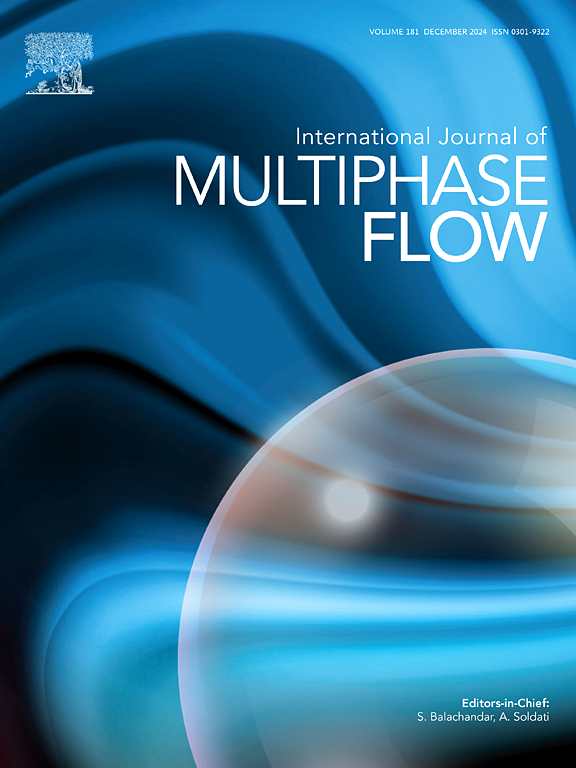垂直发散通道中的流动沸腾:介观方法
IF 3.8
2区 工程技术
Q1 MECHANICS
International Journal of Multiphase Flow
Pub Date : 2025-09-15
DOI:10.1016/j.ijmultiphaseflow.2025.105446
引用次数: 0
摘要
本文采用基于多重弛豫时间的伪势晶格玻尔兹曼方法,对垂直发散通道内的流动沸腾现象进行了数值研究。详细探讨了操作参数和几何参数对分流通道内流动沸腾特性的影响,并与相同进口宽度的直道内流动沸腾特性进行了比较。深入研究了两个离散微加热器在流动方向上变节距时气泡的聚并及其对传热的影响。通过使用多个离散微加热器来确定两个通道中段塞流气泡产生的临界壁面过热度,研究了变壁面过热度下由气泡流到段塞流的流动模式演变过程。结果表明,直线通道中段塞气泡形成的临界过热度低于分流通道。模拟结果表明,发散通道比直通道具有更高的气泡生长速率和更好的换热性能,并且在发散角范围内,随着发散角的增大,气泡生长速率和换热性能的影响更为明显。增大壁面过热度和流量可以提高气泡的离开频率和换热。研究还表明,在给定条件下,存在最大平均热流密度的最佳螺距。本研究的发现有助于理解流动沸腾在不同几何和操作修改下的热流体力学特性的演变,从而有助于制定更好的冷却应用设计策略。本文章由计算机程序翻译,如有差异,请以英文原文为准。

Flow boiling in a vertical diverging channel: Mesoscopic approach
The present study aims to numerically investigate the flow boiling phenomenon inside a vertical diverging channel by using the Multi-Relaxation Time based Pseudopotential Lattice Boltzmann method. The effects of operational and geometrical parameters on the flow boiling characteristics in the diverging channel are explored in detail and compared with those in the straight channel with the same inlet width. The coalescence of bubbles and its effects on heat transfer under variable pitch distances between two discrete microheaters in the flow direction are examined thoroughly. The evolution of the flow pattern from bubbly to slug flow under variable wall superheats is performed by using multiple discrete microheaters to determine the critical wall superheat for the initiation of slug bubbles in both channels. The results indicate a lower critical superheat for the initiation of slug bubble formation in the straight channel than in the diverging channel. The simulation results suggest that the diverging channel exhibits a higher bubble growth rate with better heat transfer capability than the straight channel does and, for the range of diverging angles studied, the effects are more pronounced with an increase in the diverging angle. The bubble departure frequency and heat transfer are enhanced by increasing the wall superheat and flow rate. The current study also revealed that there is an optimum pitch distance for the maximum average heat flux under a given condition. The findings of the current study help to understand the evolution of thermo-hydrodynamics characteristics of flow boiling under variable geometrical and operational modifications, which helps to develop a better design strategy for cooling applications.
求助全文
通过发布文献求助,成功后即可免费获取论文全文。
去求助
来源期刊
CiteScore
7.30
自引率
10.50%
发文量
244
审稿时长
4 months
期刊介绍:
The International Journal of Multiphase Flow publishes analytical, numerical and experimental articles of lasting interest. The scope of the journal includes all aspects of mass, momentum and energy exchange phenomena among different phases such as occur in disperse flows, gas–liquid and liquid–liquid flows, flows in porous media, boiling, granular flows and others.
The journal publishes full papers, brief communications and conference announcements.

 求助内容:
求助内容: 应助结果提醒方式:
应助结果提醒方式:


